The exhibition that opened at the Louvre this week to mark the 500th anniversary of Leonardo da Vinci’s death appears to have fulfilled his ambition “to leave an imperishable memory among mortals”.
Leonardo created drawings and paintings of ineffable mystery and beauty. The exhibition, which continues until February, emphasises his belief that painting was the greatest art, but it also pays homage to his scientific genius.

It took curators 10 years to assemble the largest number of Leonardo's paintings, drawings, sketches and manuscripts ever shown together. The exhibition is routinely described as a blockbuster and the cultural event of the season.
More than 260,000 visitors booked tickets before it opened, and the Louvre expects it to surpass the previous record of 540,000 visitors to the Delacroix exhibition last year. Tickets must be prebooked on the internet.
For the past 11 months there has been near continuous coverage of negotiations with Italy and the shadowy owner of the Salvator Mundi, the world's most expensive painting, for the loan of their possessions.
"The French can't have everything," Lucia Borgonzoni, then a deputy culture minister from Matteo Salvini's far right-wing League, told the Corriere della Sera last November. "Leonardo is Italian. He only died in France, " she added, echoing the sentiments of many Italians.
A Venice court ruled that Leonardo's Vitruvian Man could be sent to Paris, but only for two months, after which it must be stored in darkness for eight years
Amid fraught relations between President Emmanuel Macron and the previous far-right-dominated Italian government, Italy reconsidered an exchange agreement concluded in 2017.
The loans at risk included the Vitruvian Man, Leonardo’s anatomical study of a naked man inside a square and circle, symbolising harmony in the universe. The Italian government fell. The French culture minster and his new Italian counterpart resolved the dispute.
Then a cultural-heritage group tried to block the loan of the Vitruvian Man. In an 11th-hour decision a Venice court ruled that Leonardo’s drawing could be sent to Paris, but only for two months, after which it must be stored in darkness for eight years.
Uncertainty about the loan of Salvator Mundi, a painting of Christ in Renaissance robes, created a second cliffhanger in the run-up to the show’s official opening, on October 24th. An anonymous buyer, believed to be the Saudi crown prince, Mohamed bin Salman, purchased the painting at auction for $450 million in 2017, despite lingering doubts about its authenticity. The Louvre continued to negotiate with an unnamed middleman until the last minute.
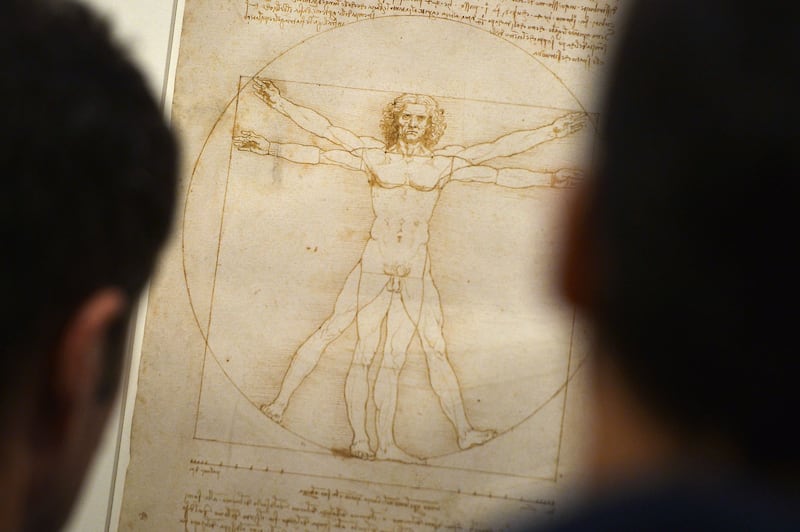
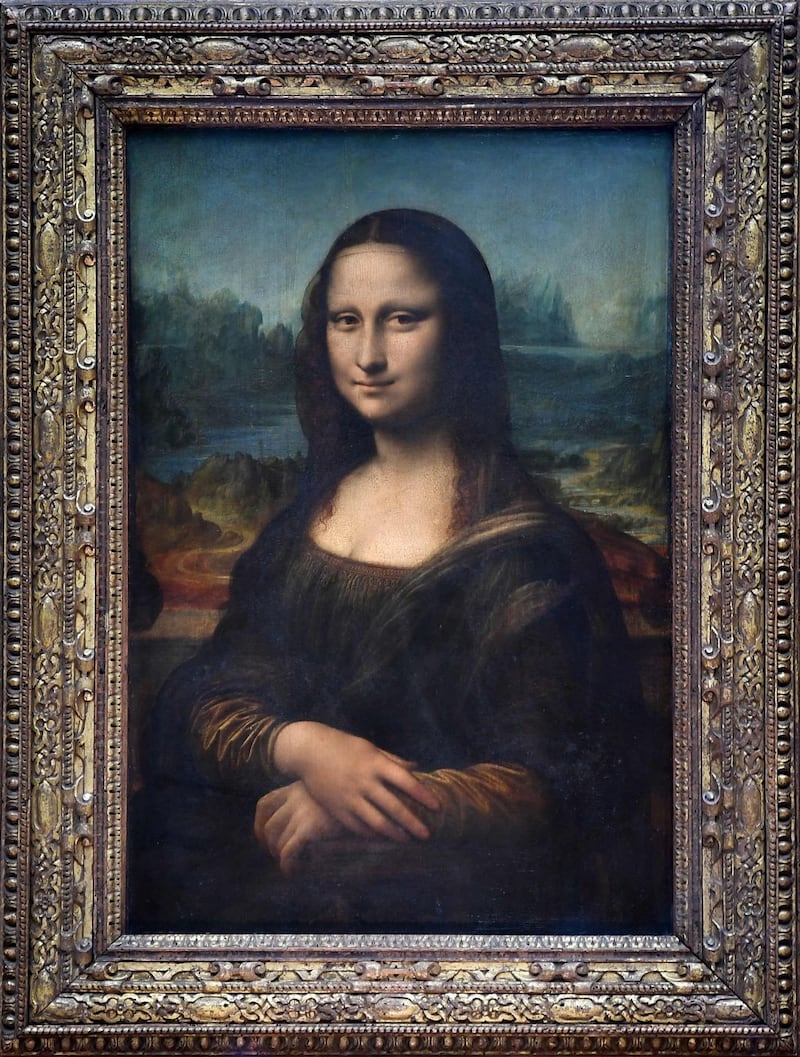
The absence of other Leonardos is felt more keenly than that of Salvator Mundi. The Uffizi said its Annunciation was too fragile to travel. The National Gallery in Washington, DC, and the Polish National Museum, in Cracow, said their portraits of Ginevra de Benci and Cecilia Gallerani (known as Lady with an Ermine) were crucial to the identity of their museums, and that they could not deprive their public of the portraits' presence.
The Louvre exhibition includes infrared reflectograms of the missing paintings. These black-and-white X-ray-like pictures show how Leonardo created the masterpieces, but they are scant comfort for their absence.
There are about 15 oil paintings by Leonardo in existence. He worked very slowly – for 16 years, for example, on The Virgin and Child with St Anne, known simply as St Anne. He did not sign his paintings, and never considered any canvas finished. It is sometimes a challenge for experts to distinguish between his work and that of his atelier.
The most famous painting of all, the Mona Lisa, is technically not part of the show: 30,000 people queue to see her daily, but the exhibition space can receive only 7,000. So Mona Lisa has been left in her glass cage upstairs
With five Leonardo paintings – the world’s single largest collection – the Louvre had a headstart organising the exhibition. Italy, the Vatican and Russia lent paintings, but none compare with those already owned by the Louvre.
The most famous painting of all, the Mona Lisa, is technically not part of the show. Thirty thousand people queue to see her daily, and the cramped exhibition space can receive only 7,000 per day. So Mona Lisa has been left in her glass cage upstairs.
Mona Lisa, St Anne, and St John the Baptist were the paintings that Leonardo took with him to France, where he spent the last three years of his life at the invitation of the Renaissance king Francis I. He worked on all three canvases until his death.
"These three paintings are Leonardo's pictoral testament," says Vincent Delieuvin, co-commissioner of the exhibition. Their faces resemble one another, particularly their mysterious smiles, to such an extent that St John the Baptist is sometimes called the brother of Mona Lisa.
The Renaissance artist and historian Giorgio Vasari described Mona Lisa as life itself. He even fancied he could see blood pulsing in her veins.
“Every painter paints himself,” Leonardo wrote. It has been suggested that Mona Lisa was a self-portrait by Leonardo. She was almost certainly the wife of the Florentine silk merchant Francesco del Giocondo, but Leonardo idealised her and other subjects’ faces to conform to his ideal of beauty.

St John the Baptist was the last painting Leonardo undertook before his death, in 1519. A young man with curly locks emerges from the night, clad in animal skins. Leonardo said he wanted “to make the invisible visible”. His St John the Baptist brings to life the Gospel of St John, chapter 1, verses 5-8: “And the light shineth in darkness; and the darkness comprehended it not. There was a man sent from God, whose name was John… He was not that Light, but was sent to bear witness of that Light.”
St John the Baptist’s right index finger points heavenward, but his eyes and smile seem to speak of earthly pleasure. He is profoundly ambiguous, at the same time mystical and sensual, ethereal and androgenous, a fleeting apparition who dissolves into the inky background.

Leonardo wrote that “a good painter must represent two things: the person and their state of mind or soul. The first is simple, the second more difficult.” When he dissected human cadavers, Leonardo tried to discover the physical location of the soul.
As he aged, Leonardo removed extraneous detail from his paintings. There is virtually no colour, no background, no scenery, only light and shadow in St John the Baptist. It is a tour de force of sfumato, the technique used by Leonardo to endow his paintings with a lifelike sense of movement. From the Italian word fumo, or smoke, sfumato was achieved by applying layer upon layer of translucent paint, blurring original lines to create a vaporous effect.
Some art historians believe that Salaï – a nickname meaning imp – was the model for St John the Baptist. The son of poor peasants, Salaï moved into Leonardo’s house at the age of 10, when Leonardo was 38. He was the painter’s assistant, companion, secretary and, possibly, lover.
The exquisite, unfinished oil painting Head of a Woman, also known as La Scapigliata, is perhaps the best example of Leonardo’s belief in the power of the non finito or unfinished artwork. The young woman’s face resembles the visages of the angel in The Virgin of the Rocks, of St Anne and St John the Baptist.
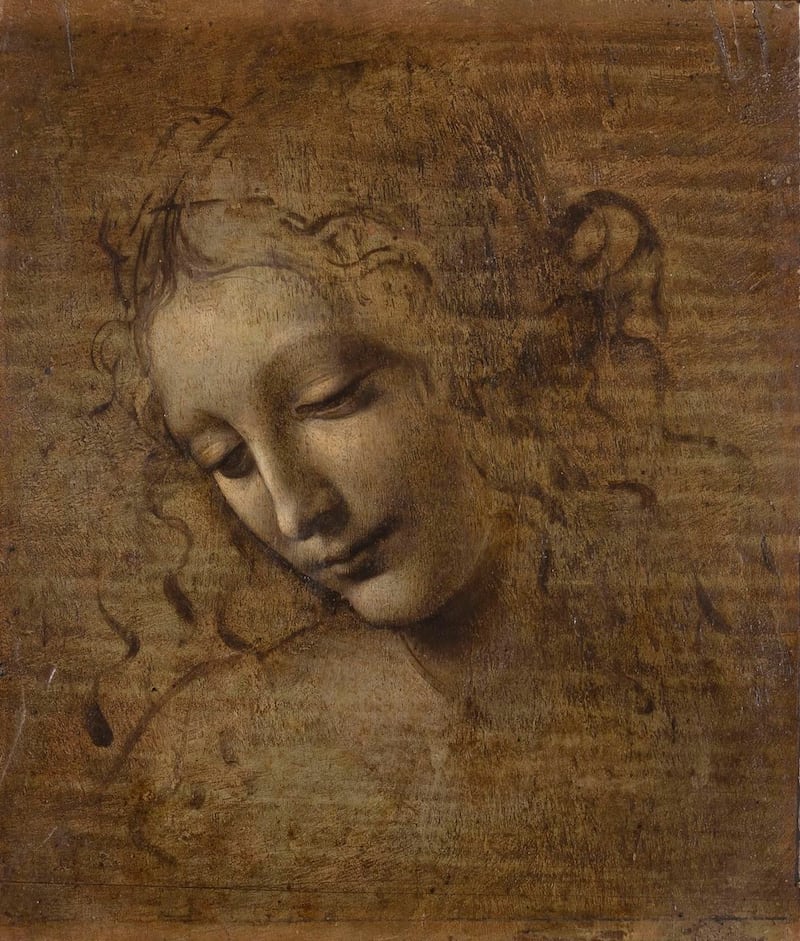
Delieuvin, the commissioner, says St Anne is “perhaps the greatest masterpiece of Leonardo. In its representation of the world it is more complete than the Mona Lisa and St John the Baptist.”
The National Gallery in London lent its cartoon or preparatory drawing for St Anne. Along with the painting’s infrared reflectogram, it reveals how Leonardo simplified the painting’s pyramidal structure over many years. The bodies of St Anne and her daughter, the Virgin, appear almost fused. All three figures turn, creating a spiral effect. The lamb looks at Christ, who looks at his mother, who returns his gaze. There is movement in the eyes and facial expressions.
In the original cartoon St Anne seems to ask her daughter if she knows what she is getting into. Her raised, pointed finger, like that of St John the Baptist, is an indication that Christ will die.
In the final painting St Anne sits passively while the Virgin reaches towards Christ. Her faint, sad smile has changed, to imply acceptance of his sacrifice.
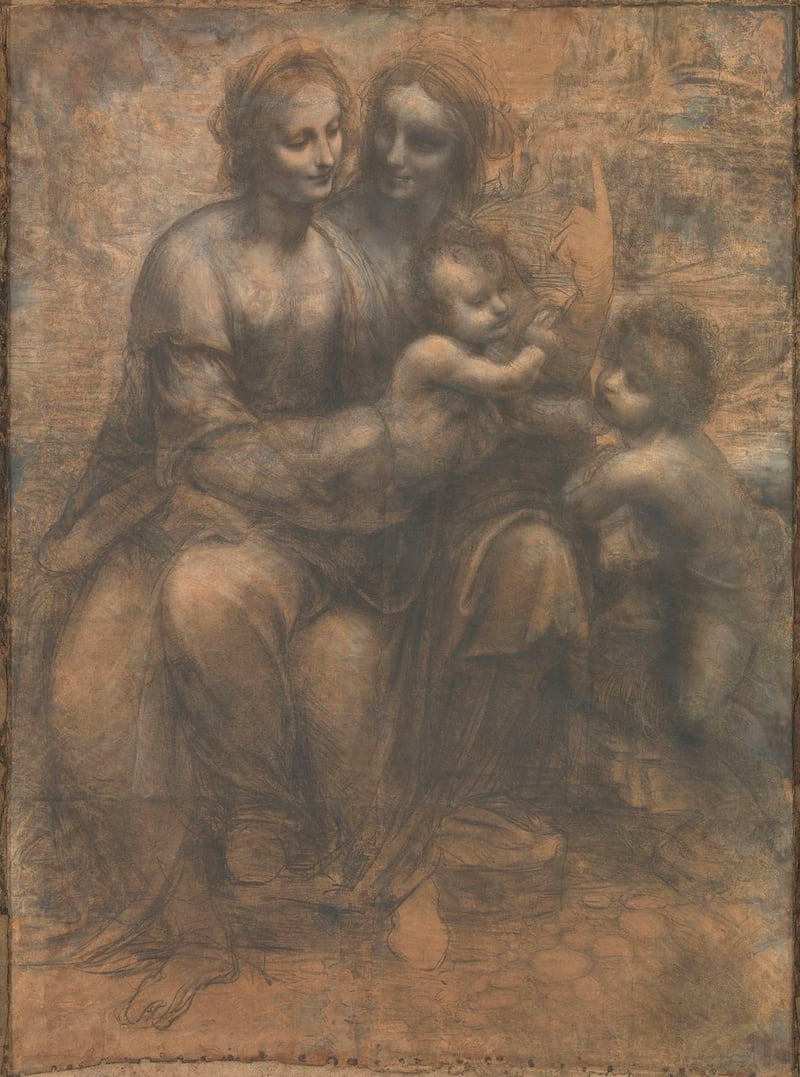

Two other paintings from the Louvre's permanent collection, The Virgin of the Rocks and La Belle Ferronière, grace an earlier room, dedicated to Leonardo's first, 1582-1600 stay in Milan, where he worked for Duke Ludovico Sforza.
La Belle Ferronière was mistakenly named for a mistress of King Francis I. The beautiful woman in a crimson dress was either Sforza’s wife or a mistress. With her expressive face that seemingly watches the viewer from the corner of the eye, she is a precursor of the Mona Lisa.
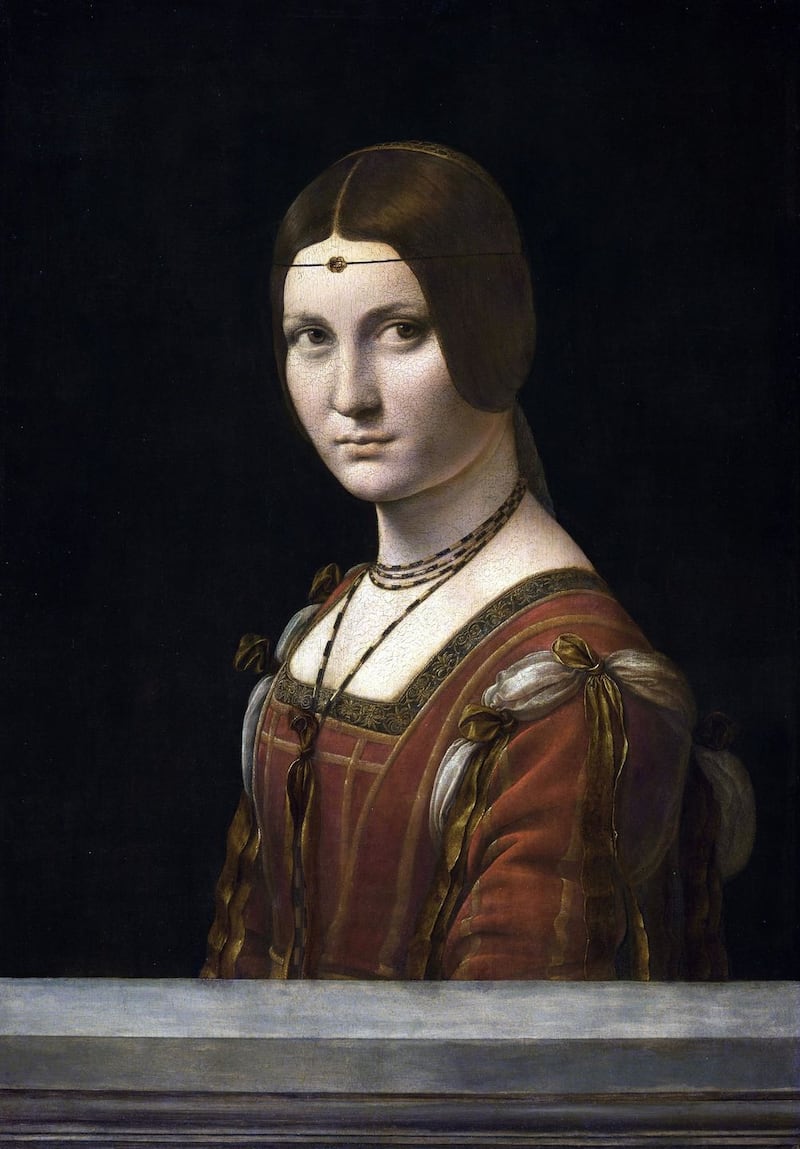
Insatiable curiosity was perhaps Leonardo’s most salient characteristic. More than 40 manuscripts in the exhibition, many with drawings, catalogue his research on human anatomy, astronomy, botany, geography, geology, geometry, meteorology, optical effects and zoology. It was an astounding sum of knowledge, by any standard.
The show starts with a bronze statue by Andrea del Verrocchio, Leonardo’s first and only teacher. It includes Leonardo’s early studies of drapery, and his first known drawing, of the Tuscan countryside. There are numerous paintings by apprentices in his atelier, copies of works that have been lost, such as his Battle of Anghiari, or which cannot be moved, including The Last Supper. It is all part of the narrative of Leonardo’s life, but sometimes it feels like superfluous padding.
The exhibition ends with a portrait of Leonardo in red chalk by Francisco Melzi, the disciple and adopted son who followed him to France, and who, along with Salaï, was Leonardo's heir. Melzi drew Leonardo as he was perceived in France, as an intellectual and philosopher in the ancient Greek tradition. Melzi bequeathed the Mona Lisa, St Anne and St John the Baptist to Francis I. Francis made the Louvre his royal palace, and home to Leonardo's greatest masterpieces.
Leonardo da Vinci is at the Musée du Louvre, in Paris, until February 24th, 2020


















